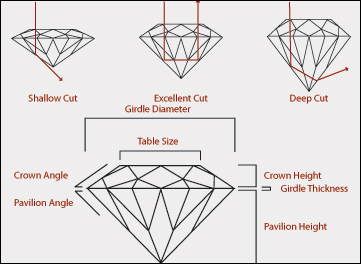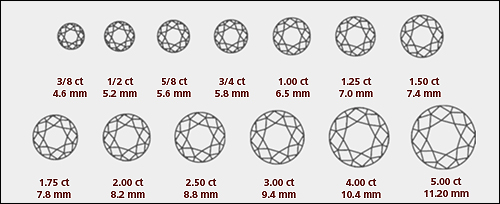Four C's of a Diamond
Fine diamonds are among the most coveted of all gems. Their value, however, differs widely from one diamond to another. Experts evaluate every diamond for rarity and beauty, using four primary guidelines. When you start to look at diamonds, you will want to know the stats on each stone. Known as the Four C's -; cut, carat, clarity, and color -; this will help you compare diamonds against each other and control your budget. (See section on Certified Diamonds for information about certification of diamonds).
CUT:
When you think of the cut, you probably think of the shape of the diamond. You are partially correct. While cut does refer to shape, it also refers to the proportions of how the diamond is actually cut. Diamonds are cut into many different shapes, reflecting not only popular taste but the proportions and quality of the rough diamond. The most popularshapes are round, princess cut, and cushion cut. Many cuts are available including oval, emerald, heart, and marquise along with specialty cuts such as heart shaped diamonds. A diamond's overall proportions, as well as the size and placement of its many reflective surfaces or facets, also play a large part in "cut." The consistency and balance of these can greatly affect how the stone captures light and reflects it back to the eye.

CLARITY:
A diamond's clarity is measured by the existence, or absence, of visible flaws. Tiny surface blemishes or internal inclusions -- even those seen only under magnification with a jeweler's loupe -- can alter the brilliance of the diamond and, thus, effects its value. Clarity levels begin with Flawless (F & IF) and move down to Very Very Slight (VVS1 & 2), Very Slight (VS1 & 2), Slightly Included (SI1 & 2), and Included (I1, 2 & 3).
FL, IF Diamonds Flawless: No internal or external flaws Internally Flawless: No internal flaws
VVS1, VVS2 Diamonds Very, Very Slightly Included: Very difficult to see inclusions under 10% magnification.
VS1, VS2 Diamonds Very Slightly included: Inclusions are not typically visible to the unaided eye,
SI1, SI2 Diamonds Slightly included: Inclusions are visible under 10× magnification and may be visible to the unaided eye.
I1, I2, I3 Diamonds Included: Inclusions are visible with the unaided eye.
Four C's of a Diamond
Fine diamonds are among the most coveted of all gems. Their value, however, differs widely from one diamond to another. Experts evaluate every diamond for rarity and beauty, using four primary guidelines. When you start to look at diamonds, you will want to know the stats on each stone. Known as the Four C’s – cut, carat, clarity, and color – this will help you compare diamonds against each other and control your budget. (See section on Certified Diamonds for information about certification of diamonds).
COLOR:
With the exception of some fancy colored diamonds, the most valuable diamonds are those with the least color. The color scale for transparent diamonds runs from D-F (colorless), G-J (near colorless), K-L (faint yellow), to Z (light yellow). Completely colorless diamonds are rare.
When diamonds are formed with traces of other minerals, rare and beautiful colors can result. “Fancy" colors range from blue to brilliant yellow to red, brown, pale green, pink, and violet. Because of their rarity, colored diamonds are highly desirable and those with very saturated color may be quite valuable.
